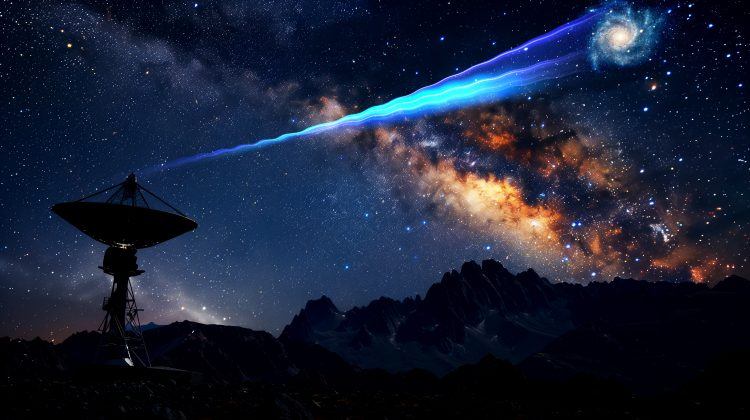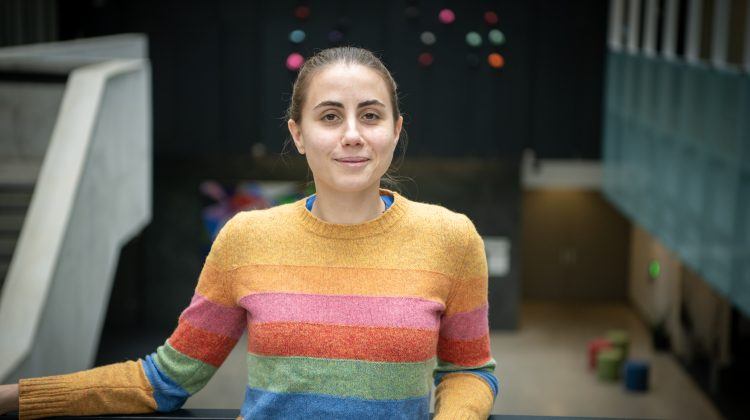An experimental test of quantum information scrambling
Perimeter Faculty member Beni Yoshida and colleagues successfully simulated the process of quantum information scrambling inside a black hole.
In early 2017, while seeking his first faculty position, Beni Yoshida visited the University of California, Berkeley, for an interview. Though he ultimately joined Perimeter Institute’s faculty as one of the first hires tied to the Institute’s growing Quantum Matter Initiative, the interview in California sparked exciting new research on quantum information scrambling, published recently in Nature.
During that interview, Yoshida met Norman Yao, a Berkeley faculty member, and they got talking about a protocol for reconstructing quantum states that Yoshida was working on with Alexei Kitaev, a long-time professor at the California Institute of Technology. Yao and Yoshida quickly deduced that this protocol could be used as an experimental verification tied to a concept called quantum information scrambling.
A collaboration was born.
A hot topic
Quantum information scrambling is an area of considerable interest in physics right now, for both theorists and experimentalists. In essence, it concerns the dispersal of local information throughout a physical system via chaotic dynamics.
Imagine you have a localized quantum bit, or qubit, with a known state. As that qubit interacts with other qubits, delocalizes, and interacts with more and more qubits in the broader system, it becomes increasingly difficult to track what happens to it. Quantum information scrambling studies how this spread of information occurs.
Quantum information theorists like Yoshida are interested in using quantum information scrambling to understand how quantum entanglement is generated in actual quantum systems – a vital ingredient to the error correction required to build a full-scale quantum computer. Condensed matter physicists are interested in quantum information scrambling as a new paradigm to understand a long-standing question concerning thermalization phenomena in isolated quantum systems (i.e., how these systems reach equilibrium).
Somewhat surprisingly, however, high-energy physicists working on black holes are perhaps even more interested in this phenomenon. Recent studies have shown that a black hole scrambles quantum information very quickly – in the fastest possible manner allowed in nature – suggesting that quantum information scrambling is the very property that makes black holes distinct from ordinary quantum systems.
Confronting the black hole information paradox
In 2007, quantum information theorists John Preskill and Patrick Hayden published a seminal paper about the black hole information paradox.
One concrete way of checking whether a black hole is destroying quantum information would be to throw something into a black hole and try to recover it. If that recovery were successful, it would provide strong evidence that no information had been erased.
If quantum mechanics is to be believed, the information that has fallen into a black hole can actually be reconstructed, but only after the black hole has shrunk to nearly half its original size. And this takes an inordinate amount of time. In the case of a black hole with the mass of our sun, it would take approximately 1067 years.
There is, however, a clever way to avoid this conclusion using Hawking radiation, the content emitted by black holes as they shrink. It may be possible to retrieve the information thrown into the black hole significantly faster by measuring weak entanglements between the black hole and the Hawking radiation it has already emitted. The Hayden-Preskill paper outlined a thought experiment in which you use this subtle entanglement structure to reconstruct the information that entered the black hole initially.
It’s a beautiful paper, says Yoshida, but it has two important drawbacks. First, the Hayden-Preskill paper used a crude approximation of black hole dynamics called “random unitary evolution.”
“Basically, you imagine all the quantum mechanical time evolutions which are mathematically possible, and you pick one of them at random,” says Yoshida. “But most of them do not actually occur in real physical systems.”
Working from this random unitary evolution framework, Hayden and Preskill proved that reconstructing the information from the black hole is indeed possible. “But they didn’t tell us how to do that,” says Yoshida. That’s the second drawback. “In fact, some people conjectured that the reconstruction is computationally difficult, even if you have access to a super-powerful quantum computer.”
Out-of-time-order correlations
In a 2016 paper, Yoshida and colleagues proposed a resolution to the first drawback using something called “out-of-time-order correlation (OTOC) functions” that involve measuring observable physical properties in the present, then the future, then reversing to measure them in the present again, and then returning to the future for one more measurement. These measurements are purely theoretical, of course – a mathematical tool that is receiving great attention.
The OTOC quantifies the effect of how small perturbations spread at later times. When the physical system undergoes chaotic dynamics, the OTOC function decays to a small value, which is a signature of quantum information scrambling.
Yoshida and his colleagues showed that quantum information scrambling is what makes the Hayden-Preskill finding possible. “If this out-of-time-order correlation function decays to a small value, then mathematically you can prove that there exists a procedure to reconstruct the quantum state,” says Yoshida. It’s counterintuitive, but the chaotic dynamics of a black hole actually make it possible to reconstruct quantum states.
A crucial new insight
The OTOC decay acts as a signal that quantum information scrambling is happening. Unfortunately, a poorly executed experiment – one where the time reversal was imprecise, for example, or an experiment with lots of noise and decoherence – would result in a similar signal. They needed a method that would result in the decay of the OTOC correlation function, while also showing that quantum mechanics was followed properly and the experiment was performed precisely.
That’s where Yoshida’s work with Kitaev comes in. They had developed a rather simple protocol for reconstructing quantum states from an entangled black hole by measuring the outgoing Hawking radiation on its two sides. This work proposed a resolution to the second drawback of the Hayden-Preskill paper, concerning how to reconstruct the quantum states – but with a bonus.
“By running our protocol for actual quantum systems, we can check two things: Does the out-of-time-order correlator decay to a small value and also does the system evolve according to quantum mechanics?” explains Yoshida. “We can immediately check these two things. That’s why this protocol is useful for experimental demonstration of quantum information scrambling.”
And that’s why Norman Yao got so excited. Yoshida and Yao wrote another paper aimed at explaining the potential of the protocol as an experimental probe of quantum information.
A theorist in an experimentalist’s world
Chaotic systems are extremely sensitive to even the smallest perturbations, so OTOCs are prone to noise and decoherence. As such, experiments on quantum information scrambling require the type of precise control over quantum systems afforded by ion traps. Yoshida and Yao contacted Christopher Monroe at the University of Maryland’s Joint Center for Quantum Information and Computer Science, home to arguably the best ion trap system in the world.
Operating on a seven-qubit trapped ion quantum computer, Monroe and his colleagues implemented Yoshida and Kitaev’s protocol and measured a reconstruction fidelity of approximately 80 percent. According to the study by Yao and Yoshida, this means that at least half of the quantum state was scrambled quantum mechanically and the other half decayed by decoherence and errors. Nevertheless, that was enough to demonstrate that genuine scrambling had occurred in a three-qubit quantum circuit.
Yoshida is not an experimentalist. “I didn’t touch the apparatus,” he says, laughing. But in addition to doing the theoretical work that underpinned the experiment, he spent a lot of time discussing how to engineer the actual quantum chaotic dynamics that would scramble quantum information in a way that worked for the ion trap in question.
It was an exciting result, with potential implications not only for black hole research – Yoshida dreams of his protocol being run on a micro black hole at a high-energy supercollider someday, though not in his lifetime – but also in quantum information and condensed matter physics.
“We engineered the dynamics, but we want to take some material and study its dynamics, measure out-of-time-order correlators, and so on. That’s the next step,” says Yoshida. “This experiment has short-term goals, intermediate goals, and very long-term goals, so I feel like it’s an interesting thing to look at.”
But Yoshida knows his strengths, and he isn’t about to ditch theory for experiment.
“I have nice motivation to think about experimental observations which actually tie into very, very fundamental questions in quantum gravity,” he says. “It’s really nice that these kinds of deep, deep questions are actually connected to physical, experimental realizations. Both fields can motivate each other.”























































































